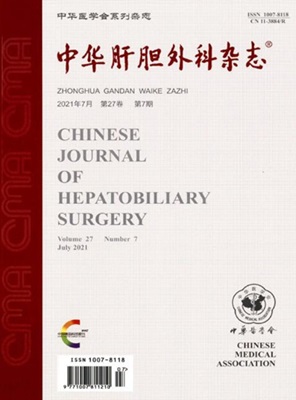胰管较细的腹腔镜胰十二指肠切除术胰空肠吻合术的不同技术
Q4 Medicine
引用次数: 1
摘要
目的探讨不同胰空肠吻合术在胰管较细的腹腔镜胰十二指肠切除术(LPD)中的应用。方法45例胰管过细患者的临床资料(0.05)。A组术后胰瘘发生率(4例)显著低于B组(6例)(12.9%比42.9%,P < 0.05)。结论陈氏缝合技术是一种安全有效的胰空肠吻合技术,适用于胰管较细的LPD患者。关键词:胰空肠吻合术;镜头辅助;胰十二指肠;纤细胰管;陈的pancreaticojejunostomy;胰瘘本文章由计算机程序翻译,如有差异,请以英文原文为准。
Different techniques of pancreaticojejunostomy in laparoscopic pancreaticoduodenectomy for patients with slim pancreatic ducts
Objective
To study the use of different techniques of pancreaticojejunostomy in laparoscopic pancreaticoduodenectomy (LPD) for patients with slim pancreatic ducts.
Methods
The clinical data of 45 patients with slim pancreatic ducts (<3 mm) who underwent LPD in People's Hospital of Zhengzhou University from May 2017 to March 2019 were studied. These patients were divided into 2 groups: Chen's suturing technique (group A, n=31), and the imbedding pancreaticojejunostomy (group B, n=14). The postoperative pancreatic fistula (PF) rates, complication rate, pancreaticojejunostomy time, and length of postoperative hospital stay were compared between the 2 groups.
Results
There was no significant difference in the general data between the two groups (P>0.05). The incidence of postoperative pancreatic fistula in group A (4 cases) was significantly lower than that in group B (6 cases) (12.9% vs. 42.9%, P 0.05).
Conclusion
Chen's suturing technique was a safe and effective pancreaticojejunostomy technique in LPD carried out in patients with slim pancreatic duct patients.
Key words:
Pancreaticojejunostomy; Laparoscopes; Pancreaticoduodenectomy; Slim pancreatic duct; Chen's pancreaticojejunostomy; Pancreatic fistula
求助全文
通过发布文献求助,成功后即可免费获取论文全文。
去求助
来源期刊

中华肝胆外科杂志
Medicine-Gastroenterology
CiteScore
0.20
自引率
0.00%
发文量
7101
期刊介绍:
Chinese Journal of Hepatobiliary Surgery is an academic journal organized by the Chinese Medical Association and supervised by the China Association for Science and Technology, founded in 1995. The journal has the following columns: review, hot spotlight, academic thinking, thesis, experimental research, short thesis, case report, synthesis, etc. The journal has been recognized by Beida Journal (Chinese Journal of Humanities and Social Sciences).
Chinese Journal of Hepatobiliary Surgery has been included in famous databases such as Peking University Journal (Chinese Journal of Humanities and Social Sciences), CSCD Source Journals of China Science Citation Database (with Extended Version) and so on, and it is one of the national key academic journals under the supervision of China Association for Science and Technology.
 求助内容:
求助内容: 应助结果提醒方式:
应助结果提醒方式:


